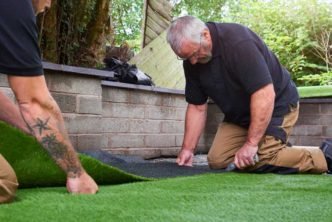Autumn is a time of change, and for many homeowners, that means it’s time to switch up their lawn care routine. There are several things you can do to make sure your lawn stays healthy all winter long, and in this article we’ll outline some of the most important steps. Keep reading to learn more!
Table of Contents
The Importance of Autumn Lawn Care
As the days grow shorter and the weather starts to cool off, it’s important to start thinking about your lawn care routine for autumn. The autumn months are a crucial time for your lawn, as they’re when it goes into its dormant stage. If you take the right steps during this time, you can help your lawn stay healthy all winter long.
So what exactly should you do? Here are a few key things:
Aeration
One of the best things you can do for your lawn in autumn is aerate it. Aeration involves making small holes in the soil to allow air, water, and nutrients to reach the roots of your grass. This is especially important if your lawn is compacted or has a lot of thatch. You can rent an aerator from your local hardware store, or hire a lawn care professional to do it for you.
Fertilization
Another important step in autumn lawn care is fertilization. Fertilizing your lawn gives it the nutrients it needs to stay healthy during the winter months. Look for a fertilizer that’s specifically designed for fall use, and apply it according to the manufacturer’s instructions.
Overseeding
Overseeding is another great way to ensure a healthy lawn this winter. Overseeding involves planting new grass seed in your lawn to help fill in any bare or thin spots. This is especially important if you live in an area with harsh winters, as the new grass will be better able to withstand the cold weather.
Clean yard waste
Be sure to clean up any yard waste such as leaves, twigs, and debris. This will help prevent pests and diseases from taking hold in your lawn. You can either rake up the debris by hand or use a lawn mower with a bagging attachment.
Mow your lawn
Continue your regular lawn care and mowing routine into early fall. For your last mow of the year be sure to only cut your grass to the ideal length of 2-1/2 inches. This will help protect your lawn from winter damage and allow it to grow withouot becoming unruly during the upcoming winter months.
Kill any weeds
Be sure to kill any weeds that are present in your lawn. Weeds compete with your grass for water, nutrients, and space, so it’s important to get rid of them. You can use a chemical herbicide or pull them by hand.
How to spot any lawn disease
Lawn diseases can often be difficult to spot, but if you know what to look for, you can catch them early and treat them accordingly. Here are a few tips on how to spot any lawn disease:
Look for signs of wilting
If your lawn is starting to wilt, it could be a sign of a lawn disease. Wilting is usually caused by a lack of water or nutrients, but it can also be a symptom of a disease.
Watch for brown patches
If you start to see brown patches in your lawn, that could also be a sign of a disease. Brown patches are usually caused by overwatering, pests, or diseases.
Check for fungus growth
Fungus growth is another common sign of a lawn disease. Fungus can often be identified by its characteristic mushroom-like appearance.
If you notice any of these signs in your lawn, it’s important to take action right away. Lawn diseases can often spread quickly, so it’s best to address them as soon as possible. Contact your local garden center or lawn care professional for additional advice on how to treat the disease.
How to treat lawn diseases
If you notice any of the signs of lawn disease mentioned above, it’s important to take action right away. Lawn diseases can often spread quickly, so it’s best to address them as soon as possible. Contact your local garden center or lawn care professional for additional advice on how to treat the disease.
There are a few ways to treat lawn diseases:
Chemical herbicides
One way to treat a lawn disease is by using a chemical herbicide. This is a quick and easy way to get rid of the disease, but it can also be harmful to your grass and the environment.
Herbal sprays
Another option for treating a lawn disease is by using an herbal spray. This is a more natural way to get rid of the disease, and it won’t harm your grass or the environment. However, it can be more time-consuming and may not be as effective as a chemical herbicide.
Pulling weeds by hand
If you only have a few weeds in your lawn, you can remove them by hand. This is a slow and tedious process, but it’s one of the most environmentally-friendly ways to get rid of weeds.
Using a lawn mower with a bagging attachment
If you have a lot of leaves, twigs, or debris in your yard, you can use a lawn mower with a bagging attachment to clean it up. This is an easy way to get rid of yard waste without having to do any extra work.
No matter what method you choose, it’s important to take action as soon as you notice any signs of lawn disease. The sooner you address the problem, the easier it will be to treat.
Final Thoughts on Autumn Lawn Care
Autumn is a great time to give your lawn some TLC. There are several things you can do to change your routine and help your lawn prepare for the winter months. Be sure to mow your grass short, kill any weeds, and check for signs of disease. If you notice any problems, don’t hesitate to take action. There are a few ways to treat lawn diseases, so there’s no need to panic. Just be sure to contact your local garden center or lawn care professional for additional advice.





